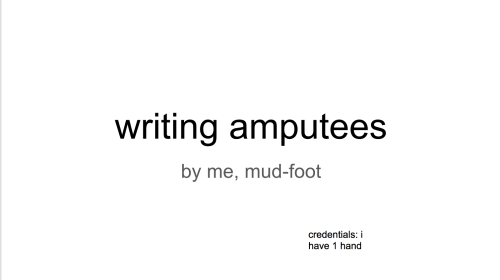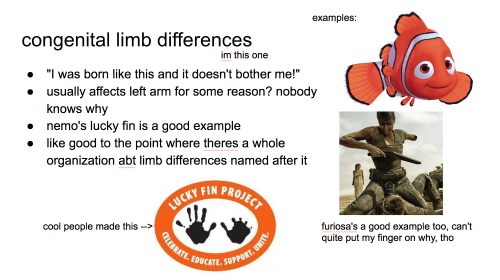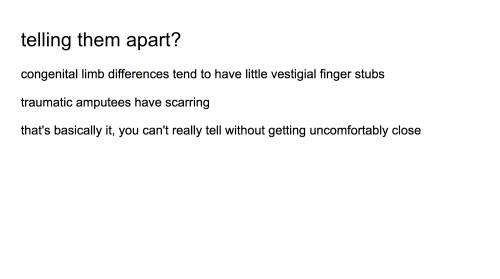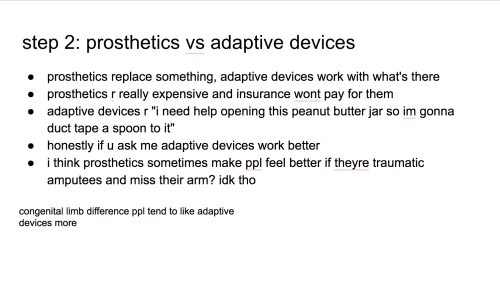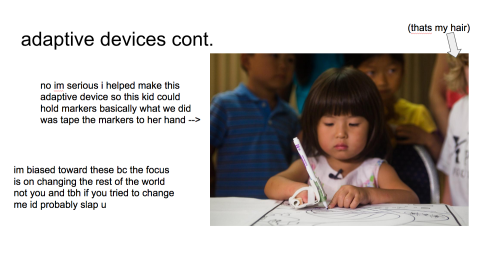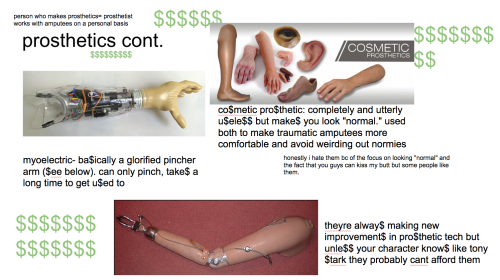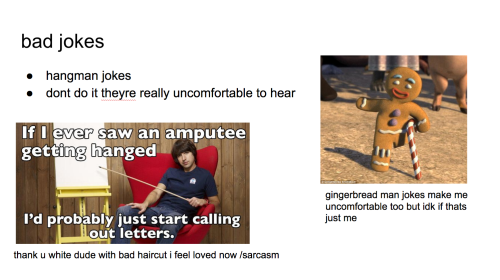Cicilearns-stories - Tumblr Posts
romanticizing mental illness is dangerous and misleading
Writing Traumatic Injuries References
So, pretty frequently writers screw up when they write about injuries. People are clonked over the head, pass out for hours, and wake up with just a headache… Eragon breaks his wrist and it’s just fine within days… Wounds heal with nary a scar, ever…
I’m aiming to fix that.
Here are over 100 links covering just about every facet of traumatic injuries (physical, psychological, long-term), focusing mainly on burns, concussions, fractures, and lacerations. Now you can beat up your characters properly!
General resources
WebMD
Mayo Clinic first aid
Mayo Clinic diseases
First Aid
PubMed: The source for biomedical literature
Diagrams: Veins (towards heart), arteries (away from heart) bones, nervous system, brain
Burns
General overview: Includes degrees
Burn severity: Including how to estimate body area affected
Burn treatment: 1st, 2nd, and 3rd degrees
Smoke inhalation
Smoke inhalation treatment
Chemical burns
Hot tar burns
Sunburns
Incisions and Lacerations
Essentials of skin laceration repair (including stitching techniques)
When to stitch (Journal article–Doctors apparently usually go by experience on this)
More about when to stitch (Simple guide for moms)
Basic wound treatment
Incision vs. laceration: Most of the time (including in medical literature) they’re used synonymously, but eh.
Types of lacerations: Page has links to some particularly graphic images–beware!
How to stop bleeding: 1, 2, 3
Puncture wounds: Including a bit about what sort of wounds are most likely to become infected
More about puncture wounds
Wound assessment: A huge amount of information, including what the color of the flesh indicates, different kinds of things that ooze from a wound, and so much more.
Home treatment of gunshot wound, also basics More about gunshot wounds, including medical procedures
Tourniquet use: Controversy around it, latest research
Location pain chart: Originally intended for tattoo pain, but pretty accurate for cuts
General note: Deeper=more serious. Elevate wounded limb so that gravity draws blood towards heart. Scalp wounds also bleed a lot but tend to be superficial. If it’s dirty, risk infection. If it hits the digestive system and you don’t die immediately, infection’ll probably kill you. Don’t forget the possibility of tetanus! If a wound is positioned such that movement would cause the wound to gape open (i.e. horizontally across the knee) it’s harder to keep it closed and may take longer for it to heal.
Broken bones
Types of fractures
Setting a broken bone when no doctor is available
Healing time of common fractures
Broken wrists
Broken ankles/feet
Fractured vertebrae: Neck (1, 2), back
Types of casts
Splints
Fracture complications
Broken noses
Broken digits: Fingers and toes
General notes: If it’s a compound fracture (bone poking through) good luck fixing it on your own. If the bone is in multiple pieces, surgery is necessary to fix it–probably can’t reduce (“set”) it from the outside. Older people heal more slowly. It’s possible for bones to “heal” crooked and cause long-term problems and joint pain. Consider damage to nearby nerves, muscle, and blood vessels.
Concussions
General overview
Types of concussions 1, 2
Concussion complications
Mild Brain Injuries: The next step up from most severe type of concussion, Grade 3
Post-concussion syndrome
Second impact syndrome: When a second blow delivered before recovering from the initial concussion has catastrophic effects. Apparently rare.
Recovering from a concussion
Symptoms: Scroll about halfway down the page for the most severe symptoms
Whiplash
General notes: If you pass out, even for a few seconds, it’s serious. If you have multiple concussions over a lifetime, they will be progressively more serious. Symptoms can linger for a long time.
Character reaction:
Shock (general)
Physical shock: 1, 2
Fight-or-flight response: 1, 2
Long-term emotional trauma: 1 (Includes symptoms), 2
First aid for emotional trauma
Treatment (drugs)
WebMD painkiller guide
Treatment (herbs)
1, 2, 3, 4
Miscellany
Snake bites: No, you don’t suck the venom out or apply tourniquettes
Frostbite
Frostbite treatment
Severe frostbite treatment
When frostbite sets in: A handy chart for how long your characters have outside at various temperatures and wind speeds before they get frostbitten
First aid myths: 1, 2, 3, 4, 5 Includes the ones about buttering burns and putting snow on frostbite.
Poisons: Why inducing vomiting is a bad idea
Poisonous plants
Dislocations: Symptoms 1, 2; treatment. General notes: Repeated dislocations of same joint may lead to permanent tissue damage and may cause or be symptomatic of weakened ligaments. Docs recommend against trying to reduce (put back) dislocated joint on your own, though information about how to do it is easily found online.
Muscular strains
Joint sprain
Resuscitation after near-drowning: 1, 2
Current CPR practices: We don’t do mouth-to-mouth anymore.
The DSM IV, for all your mental illness needs.
Electrical shock
Human response to electrical shock: Includes handy-dandy voltage chart
Length of contact needed at different voltages to cause injury
Evaluation protocol for electric shock injury
Neurological complications
Electrical and lightning injury
Cardiac complications
Delayed effects and a good general summary
Acquired savant syndrome: Brain injuries (including a lightning strike) triggering development of amazing artistic and other abilities
Please don’t repost! You can find the original document (also created by me) here.
lifehack: when you see a Take One candy bowl in a restaurant, wait until noones looking and shovel candy into your pockets. god may judge you but his sins outnumber your own
ATTENTION WRITERS
Google BetaBooks. Do it now. It’s the best damn thing EVER.

You just upload your manuscript, write out some questions for your beta readers to answer in each chapter, and invite readers to check out your book!
It’s SO easy!

You can even track your readers! It tells you when they last read, and what chapter they read!

Your beta readers can even highlight and react to the text!!!

There’s also this thing where you can search the website for available readers best suited for YOUR book!
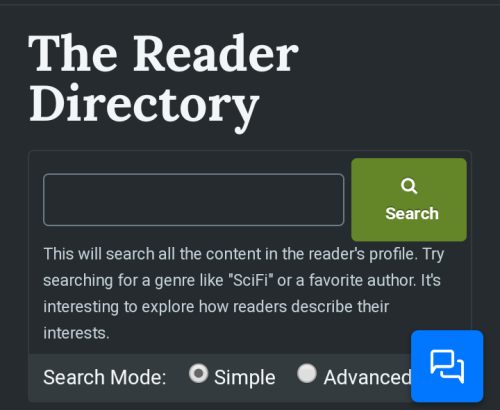
Seriously guys, BetaBooks is the most useful website in the whole world when it comes to beta reading, and… IT’S FREE.
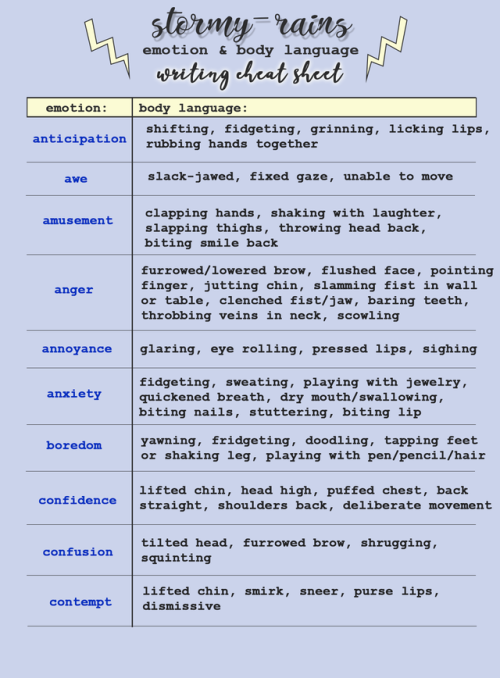
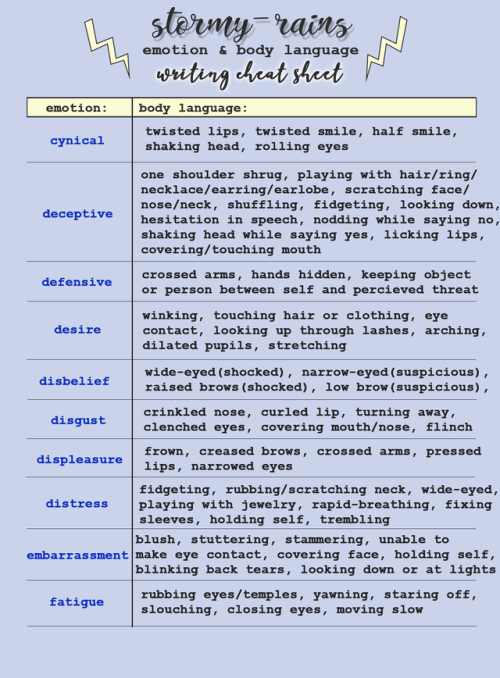

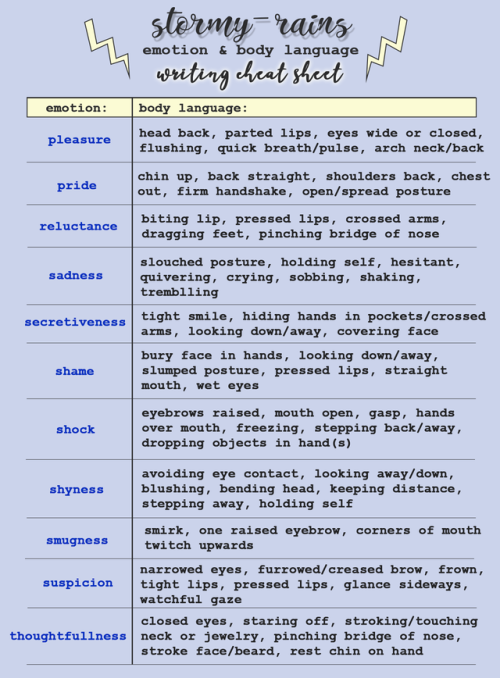
A Writing Cheat Sheet: for linking actions with emotions.
As always, click for HD.
for all of you guys that are writing fantasy and getting into fantasy cartography, i highly, highly recommend that you sit through artifexian’s youtube series on building realistic fantasy maps
he basically breaks down stuff like how to realistically place climate zones on a map, what they look like, how ocean currents work, how they affect things (like where your world’s fishing hubs and climates are going to be placed), where mountain ranges should go and how they affect climate, where your world’s metals (i.e. resource wealth) are going to be found, and on and on and on. it’s SUPER incredibly fucking helpful and really fleshes your world out in a whole new way
Writing Advice Posts: A Handy Reference Guide
(Updated 03/18/20) Hey all, I’ve got quite a few writing advice posts & answered Asks on my blog at this point, so I’m making this reference guide to make it easier to find what you’re looking for. Hope it helps!
Free Pocket Guide to Self Editing for Fiction Writers
A collection of 5 checklists to help you map out a revision plan and move forward with your story.
Pre-Editing Checklist
Story Editing Checklist
Scene Editing Checklist
Sentence Editing Checklist
Post-Editing Checklist
Download the pocket guide for free right here.
Free Resource Library Downloads
All of these PDFs are also available to download for free on my website:
Creating Character Arcs Workbook
Point of View Cheatsheet
Dialogue Checklist
Setting Checklist
Questions to Ask Before Hiring an Editor Printable Checklist
Proper Manuscript Format Printable Checklist
Short Story & Novel Submission Templates
World-Building Checklist
Access the Free Resource Library right here.
General
8 Ways to Improve Your Writing
10 Best Books About Writing Fiction
How to Spot Bad Writing Advice: 6 Red Flags to Look For
“Show Don’t Tell”? Not Always. Here’s When to Use Summary
How to start a story
More about starting stories
The first sentence
Weak words
Why Just About Every Published Book in the World Does 57 Things That Just About Every Book About Writing Tells You Not to Do
Creative Nonfiction Cliches to Avoid
How to Read Like a Writer
How to Write During a Pandemic
The Writing Process, Writer’s Block, & Inspiration
To all the Writers Suffering from Depression
How to Train Yourself to Write Faster
Just a friendly reminder that creativity is difficult to quantify.
Quick Writing Tip: Make a Note to Your Future Self in Your WIP
Quick Writing Tip: Take Notes!
Just a friendly reminder that writing is not always a linear process.
Quick Cure for Writer’s Block: Lower Your Expectations
Set Realistic Goals
Your Skills May Need Time to Catch Up to Your Vision
It’s Okay to Experiment and Be Weird As Fuck
Surround Yourself With Supporters
It’s okay to take a break.
Your First Draft is Raw Material
Getting into “The Zone”
Vomit Brain
Writing from Your Imagination vs. Reality
Dealing with Criticism
Getting Bored with Your Own Writing
Getting past a block
Doing research on topics you don’t have first-hand experience with
Journalling about your writing
How to Keep Yourself From Editing As You Write
Advice for Getting Over a Writing Slump
Dealing with Procrastination
How to Write Like You Used to, Before You Learned Stuff that Fucked Up Your Natural Creative Flow and Turned Your Writing into Boring, Stilted Garbage
Concept: Maybe Your First Draft DOESN’T Suck
Character Development
Creating Character Arcs with the DCAST Method
What Does Your Main Character Want?
How to Activate Your Passive Characters, One Verb at a Time
How to Use Description to Show Character Development
How to Create a Non-Cliched First-Meeting Scene
The “It Depends” Post
Shifting internal goals
When to identify your character’s goal
Writing about normal people with normal problems
If you’re worried about your character being too similar to someone else’s character
Describing your characters without messing up your pacing
Story, Plot, & Pacing
Quick Plotting Tip: Write Your Story Backwards
Pause at the Threshold
How to Spot an “Info-dump”
Slowing Down the Pace of Your Story Without Boring Your Reader
Time Transitions
How to Create a Non-Cliched First-Meeting Scene
Creating Conflict
When & how to cut a scene
If you’re good at creating characters but awful at creating plot
When you’ve plotted your story but can’t get started
En Media Res
Writing to Your Ideal Reader
Deus Ex Machina
Foreshadowing
Finding an Ending
What to write between moments of conflict
Starting a story with waking-up scene
How to Know When You’re Done Outlining
Doing a Structural Overhaul on Your Story
How to Find an Ending from a Beginning
Description, Setting, & Worldbuilding
How to Make Your Descriptions Less Boring
How to Spot an “Info-dump”
Adding Descriptions to Intense Scenes Without Messing Up Your Story’s Flow
How to Use Description to Show Character Development
Worldbuilding: How much is too much?
Modeling your fantasy world from stuff in the real world
Internal Consistency
Utilizing Sound
How to Do World-Building Research
Point of View
How to Choose the Right Point of View for Your Story
A Beginner’s Guide to Multiple Point of View
6 Questions to Ask About Your Point of View
How to decide if you should use first person or third person
More point of view basics
Head hopping
How to Head Hop without Head Hopping
What to Do When You’re Halfway Through Your Story and Realize Your POV Isn’t Working
Dialogue
How to Improve Your Dialogue
3 Ways to Make Your Dialogue More Interesting
Starting a story with dialogue
Are You Using Too Much Stage Direction?
Which is Better: Exposition or Expository Dialogue?
Publishing & Sharing Your Work
7 Tips to Build an Audience for Your Writing
Pros and Cons of Self Publishing
Quick Publishing Tip: Don’t Bury Your Gold
How to Properly Format Your Manuscript for Publication
A warning about posting writing online that you intend to publish later
Advice for writers who are worried about people stealing their work or ideas
Getting feedback on your writing
How to Create a Cover Letter for a Literary Magazine or Journal
Editing
10 Questions to Ask an Editor Before Hiring Them
Quick Revision Tip: Read Your Writing Out Loud
How to Keep Yourself From Editing As You Write
Cut the fidgeting
Are you suffering from -ing disease?
Are you Using Too Much Stage Direction?
What “Editing” Really Means
Quick Editing Tip: “That”
Quick Revision Tip: Read Faster
Editing Tip: Dialogue
Tips for Editing a Story
Should You Use a Contract When Hiring an Editor?
Quick Tip: Up & Down
Pre-Editing Checklist
Miscellaneous
The Difference Between a Semi-Colon and an Em-Dash
…if you find any broken links please let me know and I will fix them! xo
*I changed the name of my blog a while back. All of these links should work, but if you come across a “Bucket Siler has moved!” page when clicking on a link inside an old post, there’s an easy way to find what you’re looking for: In the url, delete “bucketsiler,” write “theliteraryarchitect,” then hit return. Also, let me know about it & I will fix it :)
//////////////
The Literary Architect is a writing advice blog run by me, Bucket Siler. For more writing help, check out my Free Resource Library or get The Complete Guide to Self-Editing for Fiction Writers. xoxo
i’ve been doing my homework on how to break into a writing career and honestly. there’s a Lot that i didn’t know about thats critical to a writing career in this day and age, and on the one hand, its understandable because we’re experiencing a massive cultural shift, but on the other hand, writers who do not have formal training in school or don’t have the connections to learn more via social osmosis end up extremely out of loop and working at a disadvantage.
When writing couples, I like to use the Kiss Rule:
If they have to kiss for you to know they’re in love, you’re not writing a romance right.
Naughty words in a godless world
Imagine you're writing a story that takes place in a world that has no God, or gods, or saints. What do you do with exclamations like "Oh gosh!" (derived from "Oh God") or "Jeez!" (derived from "Jesus!")? And - oh god - what do you do with curses and swear words? If your characters can't say "Oh my god", "hell no", or "damn" because there are no gods to damn anyone to hell... what are your options?
Here is a list for inspiration
In general, non-religious curse and swear words refer to local cultural taboos.
Many languages swear by referring to cleanliness: dirty, sweaty, sticky, smelly etc. This includes things you do on the toilet.
Some languages, like Dutch, use diseases as curses and insults. For example, someone nasty/bothersome might be called a "cancer sufferer" in Dutch. These swear words are combinations of (derivates of) typhus, cholera, and cancer.
Societal hierarchy and family trees, mainly the inferior positions like a bastard (seen as inferior in the family tree) or a derogatory word that refers to lower class people (seen as inferior in that society).
On the other hand, you could insult a highly valued member of the other person's family, like their mother, or of their society, like their Queen/Emperor.
Sexual taboos, often implying someone (or their mother) is more sexually active than society accepts of them.
Calling someone the word for someone's genitalia refers to the same taboo.
How do you apply this to your language?
You could use explicit/taboo words as ... :
... an intensifier: "It was a shit-hot day."
... a negative adjective: "This is a shitty job."
... an insulting noun: "This journey is shit."
Or try to be creative and combine different taboos for a multi-hit offense. My favorite one is the Spanish "I shit in your mother's milk", which combines insulting the other person's mother, the taboo of bodily functions, and the taboo of cleanliness.
During my research I came across this article, which contains a number of concrete examples from all over the world you can draw inspiration from.
And on a less offensive note, you could always make up your own equivalent of "Merlin's beard!", "Great Scott!", or "For Pete's sake!" (Pete, by the way, is a catholic reference: Pete is Saint Peter.)
I hope this was helpful. Don’t hesitate to ask me any questions, and happy writing!
Follow me for more writing advice, or check out my other writing tips here. New topics to write advice about are also always appreciated.
Tag list below the cut. If you like to be added to or removed from the list, let me know.
And if you come up with creative curses, feel free to add them in the comments :)
@therska @writingwordsaddrawingpictures @the-words-we-never-said @writingwhithotchocolate @i-rove-rock-n-roll @maskedlady @no-time-like-write-now @timefire25 @black-lakritz-dragon @nzmayart @fandomrandomness-stuff @dangertoozmanykids101 @anaestheticdisaster @storytellingofravens @purpleshadows1989 @mathematicpony @i-don-t-know-words @notquitenovelist @coffeescribles @reffaces @livingthelovelylife @katsglabella @lokitty-is-my-spirit-animal @thefallenbibliophilequote @watchmewritedumb @sting-the-scribe @kais-writing-shit @dameschnee123 @curiosityonmars @oodlittlething @nonbinarychaoticstupid
Do I mind if I ask how you approach writing longer fic? I've always struggled to write anything more than maybe two chapters long and I'm curious if you have a particular method to how you approach such stories.
Thank you so much for this ask! I absolutely love it when people ask me for writing advice because it makes me feel like a Smart Person Who Knows Things.
Before we start, here is one grain of salt to take all of this with: I have a naturally long-form brain. It is very hard for me to write something less than 1k. Short fiction is great, and there is nothing wrong with sticking to short things if that's what your brain likes to do.
So. You have decided to write a story. This is going to focus on "stories". Some people write fic that's more freeform or whatever, I am not going to cover that. What I mean by a story is this:
It starts
Some stuff happens
It ends
It is highly probable that your story contains a change of state, which could be that a villain is defeated, or a goal is reached, but it could also be that character falls in love with another, or someone learns to like broccoli.
I like to start out by completing the sentence, "This is a story where _______". This is basically like coming up with a summary for an ao3 post, except that it doesn't need to be catchy. Lots of different kinds of things could go in that blank! It could literally be what happens: This is a story where Ichigo goes back in time and punches young Aizen in the nose. It could be about what you want to explore: This is a story where Hitsugaya gets a better understanding of his zanpakutou. It could be about the vibe you want to achieve: This is an AU where everyone is in a punk rock band and has cool hair and outfits. The idea of this is to clearly define what you, the author, is interested in writing. Make sure it feels right! Maybe you pick the first one, but when you say it out loud, you say, "You know, I really just want Ichigo to go back in time so he can horse around with young Renji and Rukia and punching Aizen in the nose is just an excuse for that." That may sound dumb, but it's fine, actually! Most people don't read stories strictly for the plot, they read stories for the implications of those plots! Will my favorite two characters kiss? Will there be funny interactions between these two groups of characters? Will there be sick fights? Stories are excuses to have scenes. Sometimes, you will have a story where the interesting sequence of events is the draw, but the point is to know what you're about.
Once you feel happy with your "mission statement", you need to decide the bounds of your story: where it starts and where it ends. It may be easier to start with the end. In some cases, it may be obvious from your mission statement: everyone gets home, a villain is defeated, Kenpachi realizes the meaning of friendship. On the other hand, let's look at that punk rock AU. You've picked a vibe, but you don't really have a natural story arc. It has to have a destination, though, otherwise, it's not really a story, it's a recipe for 3 chapters of an abandoned fanfic. So brainstorm a little: Maybe they get a record deal? Maybe they win a Battle of the Bands? Maybe Byakuya accepts that the band is actually good and tells Rukia he is proud of her. Do not settle for a plot just because it works. Pick something that makes you excited! You're the one who is gonna have to write it!
I said that we needed to pick a beginning point, too, but I'm actually going to skip that for now. The next thing I do is think of all the Big Scenes I want to write, the ones you are hype to write, the ones that pop in your head as you think about the premise. Make a bullet list. They don't need to be in order. The descriptions don't need to be super detailed, but write down anything about it that is important to you. If there's a mood or a snippet of dialogue or a joke you want to make, go ahead and jot that down so you don't forget it later. What you're doing now is putting broad blotches of color on a canvas, filling in space and leaving the detail for later.
Once you are pretty happy with what you have down, try to arrange it in chronological order. Put your end at the end (if it wasn't one of your big scenes, add it now). The next task is figuring out how to traverse your scenes. You've already picked out where you want to spend the majority of your energy. The rest, I regret to tell you, is your slog writing. Now, it often happens that you will find joy in some of these scenes and your best writing may occur there, but that's serendipity. These are the scenes that you are gonna have to make yourself sit down and write, so you honestly want to limit them to just the ones you need.
So how do we do this? Look at the first thing on the list. Can you start there? If so, congrats, that's your beginning. If you can't, what needs to happen to get to there? Where can you start so that you can get to your first fun scene as soon as possible? There. That’s it. You’ve picked your beginning, good job! Now, go through the rest of your list, and add in things that must happen, even if you don’t particularly look forward to writing them. The characters need to travel from geographic point A to point B. Shuuhei needs to say something that Izuru hears and misinterprets. The Central 46 makes a new law. If you have a good idea of how these things happen, go ahead and write them down, but it’s okay if you don’t know yet. Fill in all the blanks so that if you think of each bullet list as a scene, you could read it as a story, start to end. Once you get writing, you might add more scenes, or move things around or whatever, but you should have a thing that functions as a story.
If you struggle with this, an alternative is a story with a very strong structure that is going to guide you though what you have to write.Here are two examples from my own stories Hold On, Hold On (which is only one chapter, but the principle is the same) is structured around the 5 stages of grief. Not Broken, Just Bent takes place over roughly a week, and I just decided what happened every day of the week. See You on the Other Side takes place in the middle of a bunch of canon events, which worked at mile markers.
Congratulations. You’ve just made a rough outline!
Special note for avoiding burnout!: I am a slogger. I will drag myself through the broken glass of an interminable plot to get to a single thirsty scene. That's why, at this stage, I try to look at the ratio of what I want to write to what I must write. It's gonna vary for everyone, but this is a hobby, and if looking at this proto-outline makes you feel deeply tired, maybe this isn't a good story to be devoting your time to! Can you carve it down? Can you chuck two scenes you really want to write and get rid of 80% of the slog? Or maybe you can't! In that case, just write that thirsty scene as a standalone drabble! Or just go work on something else! Maybe in the future, this one will come back to you and you’ll have a fresh idea or a renewed enthusiasm for it.
Another thing I sometimes like to do at this point is to write out some notes about my characters and their motivations and moods. Character A is homesick. Character B is so determined to defeat the enemy that they are having a hard time being sympathetic to Character A. Character C cares for both A and B and is trying to support them both. This is sort of background info that you want to keep in your head as you are writing. Depending on the type of story you are writing, this might actually be the main plot, or it might be happening subtly, but adding to the emotional impact of the story. It’s very easy for me to write these sorts of emotional arcs, but if you struggle with that, you may wish to go ahead and made a more detailed outline for that, too.
Now, it’s time to start writing! I am great at beginnings-- it is very often the case for me that the opening scene was one of my Big Tentpole Scenes. (Before you hate me too much, I make up for this by being double horrible at endings; just let me have this) Usually, I will start at the beginning and write linearly for as long as I can until I get stuck. Then, I will look forward on my outline and do the next chronological scene that I feel like writing. In general, if I sit down to write and there is something I have an urge to write, that trumps everything else. Inspiration is a precious commodity, and you should embrace it when it hits! You can slog any day. I will occasionally hold off writing a scene that I really want to, because I am saving it, like a prize for myself for getting that far. This is a very personal process of figuring out what motivates your brain and then giving your brain what it needs to be its most productive.
Eventually, you will run out of things you are excited to write, but the good news is, you’ve got a bunch of story now! Odds are that what’s left is going to be a lot of those connective tissue scenes, and you’re just going to have to do them, except that now, because you’re connecting two concrete points instead of two abstract points, it will be a lot easier. You can continue running jokes you’ve started. Maybe you invented a cafe in an earlier scene where your characters hang out and you can have them return there. Try to think of ways to make these scenes more fun, both for yourself to write and for your reader to read.
Around this time, I like to start refining that rough strokes outline into what I will call an “as-built” outline. (This is an engineering term where you update your plans or models for something to reflect any changes that had to be made along the way). This is a great activity to do at times when you feel like you have writers block. I write down every scene I have written as a 2-3 word blurb, in order. I break the scenes into what I think makes logical chapters, and I will do a word count on those prospective chapters and write it down. As you do this, you will realize that maybe you can move a scene from here to there, which will make it 1000% easier to write. Things may be happening too much, or you’ve got the characters eating three times in the same chapter. If you have subplots and dangling threads, this is where you make sure they get closure. I know this sounds very headache-y, but you are so far along in the story at this point that it’s really not-- it’s a way to look at the problems you have left. Use some sort of formatting (I like to bold things I haven’t done and sometimes I put them in red) and it gives you a very visual to-do list.
You specifically mentioned multi-chapter fanfics and I admit that I don’t tend to think in chapters, I tend to think of the story as a whole and just break it up where it feels natural. The as-built outlining I described is very helpful in making sure that my chapters feel balanced. They don’t necessarily need to be the same length, but I like them to have the same amount of stuff in them. One chapter may basically contain one long scene, and other may contain many short ones. I don’t tend to, but you can certainly have a fanfic that varies between short and long chapters, that can actually be an interesting effect. But like I said, I always like to know what I am doing, and so having it mapped out, you can say “welp, this is what I’ve done, how do I feel about that?”
Polynya, you may be saying at this point, do you write the whole fanfic before you post any of it? and I regret to inform you, the answer is yes. A lot of people write as they go, and I have made one attempt at this and I didn’t like it. I don’t like locking myself in, I just need to be able write out of order and go back and change things. Here is the story of a little in love: someone gave me an AU prompt and I got mildly obsessed with it, and wrote 5 snapshots drabbles in that universe, ending with a slight cliffhanger ending. I probably should have stopped there, but I decided to keep going. I wrote out an outline of 5 acts where the first act was detailed to the degree of each chapter being specified. The chapters here were much smaller than I usually make chapters: 1-2k. I wrote act i and ii and it was actually great, and then I hit act iii which required a lot of set up for misunderstandings and a mini romance arc. I couldn’t wing it, but nor could I figure it all out with outlining. I write dialogue in almost sort of an improv “Yes, and...?” style, so until I do it, I don’t know what’s going to happen. So, what I did was treat the second half of act iii as a complete story in the process I describe above, wrote the entire rest of it, and then posted it. One might notice that the chapter lengths grew to 3-5k each. I have two more acts to go, and I haven’t decided how I am going to do them yet, but I suspect I will treat each of them as their own mini-stories.
(I will admit that in Heart is a Muscle, I tend toward chapters that are about 10k long, and this is honestly too long, someone should smack me. If you like punchy chapters, 1-2k is good. I think 3-6k is probably an ideal chapter length. Is this how long the chapters are in my latest fanfic? Absolutely not.)
Okay, so there’s one more step, which is quality control. I am habitual re-reader-- I read my fanfics-in-progress over and over and over while I am working on them. I understand that not everyone does this, but I am usually the primary audience for my own writing, and this is the actual fun part for me. Nevertheless, you should re-read your work at least once, to make sure it hangs together.
This is purely optional, but I recommend it: get a writing friend (if you don’t like re-reading your work, I recommend this even more strongly). If you can get a full-service beta reader, that’s great, but if you can’t find someone, or if receiving that level of critique stresses you out, it’s perfectly valid to just find a friend who will read your stuff and a) shower you with compliments, b) reassure you about parts you aren’t sure about (or suggest ways to help) and c) point out any huge problems you missed. When I am writing a long fanfic, it is a huge motivational factor for me to be able to send my beta chapters as I finish them. If you are already an established writer, and you have people who consistently comment on your fic, they might be overjoyed to get a sneak peak at your work.
And that’s it! That’s the way I do it, anyway! Some people are able to sit down and write a very detailed outline and the write it start-to-finish. Good for them, I say! I have tried this and it doesn’t work great for me. I will admit that some of my fics (especially my early ones) I just sat down and banged out whole-cloth like an insane person and they are generally better than the ones I actually plan out, but that’s not a reproducible process.
As one final mechanical note, I usually write in Google Docs, which I can access on multiple devices (I used to write a lot on my phone), has convenient sharing functionality, and I use the ao3 html formatting script add-in. I generally have two documents for a single story-- one is the outline, and any other notes I want to have handy. I’ll usually put a trashcan space at the bottom for scenes that got cut but I don’t want to lose. The other is the fanfic itself.
I hope this is helpful! Please feel free to follow up with other questions and good luck with your writing!
I'm volunteering for a literary journal right now and there's two things I think you all should know.
1. Most people that submit to literary journals are cis white men. We know this because our journal has an anonymous survey about demographics for people that submit.
2. Most things that get submitted to the creative non fiction section are on the level of middle school "What I did over the summer" essays.
I cannot see the demographics of the people whose essays I'm reading, but guys, if you are wondering if you should submit your work to a literary journal or not, I promise you that just in terms of statistics there are a lot of mediocre cis white men and people in general confidently submitting weird crap that isn't literature to literature magazines. Do it. Submit your work. Please. If you want there to be more diversity in literature, be the diversity. Do it. Do it do it do it.
So... I found this and now it keeps coming to mind. You hear about "life-changing writing advice" all the time and usually its really not—but honestly this is it man.
I'm going to try it.

Hot take: Actual literary analysis requires at least as much skill as writing itself, with less obvious measures of whether or not you’re shit at it, and nobody is allowed to do any more god damn litcrit until they learn what the terms “show, don’t tell” and “pacing” mean.
calling all authors!!
i have just stumbled upon the most beautiful public document i have ever laid eyes on. this also goes for anyone whose pastimes include any sort of character creation. may i present, the HOLY GRAIL:
https://www.fbiic.gov/public/2008/nov/Naming_practice_guide_UK_2006.pdf
this wonderful 88-page piece has step by step breakdowns of how names work in different cultures! i needed to know how to name a Muslim character it has already helped me SO MUCH and i’ve known about it for all of 15 minutes!! i am thoroughly amazed and i just needed to share with you guys
Oh my gosh. I just found this website that walks you though creating a believable society. It breaks each facet down into individual questions and makes it so simple! It seems really helpful for worldbuilding!

